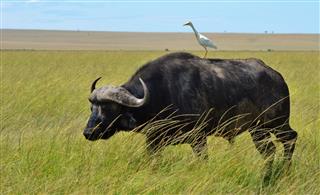
Autotrophs and heterotrophs are two types of biotic components of an ecosystem. In this article, we will learn about the characteristics of these two types of organisms, and understand how they interact with each other in an ecosystem.
All living organisms can be classified as either autotrophs or heterotrophs, based on how they fulfill their energy requirements. Autotrophs are those organisms that have the capacity to produce their own food. Heterotrophs do not produce their own food, and depend on other organisms for their survival.
What is an Ecosystem?
An ecosystem is a community of living organisms and non-living components that interact with each other in a given area or environment. A desert or a pond is an example of an ecosystem, wherein, the living organisms interact with each other as well as with the non-living components such as water, soil, climate, etc. All living organisms in an ecosystem are called biotic components, whereas the non-living ones are called abiotic components.
In an ecosystem, the flow of energy from one organism to another is described by the concept of a food chain. Each organism who is dependent on the next organism for food, forms a linear sequence, through which energy flows from one organism to another. This is referred to as the food chain, which basically means who eats whom. The biotic or the living components of the ecosystem are further divided into two categories – autotrophs and heterotrophs.
Autotrophs
Autotrophs are also called producers. They have the ability to produce their own food. Although plants constitute the majority of autotrophs, some organisms create organic food through a series of inorganic chemical reactions. There are two types of autotrophs:
Phototrophs
These are plants containing the chlorophyll pigment, and prepare their own food by acquiring energy from sunlight, and using carbon dioxide and water. Such autotrophs undergo the process of photosynthesis for preparing glucose molecules, and hence are called phototrophs. Most plants, algae, phytoplanktons, and some bacteria, fall under this category.
Chemotrophs
Some autotrophs obtain energy through a series of chemical reactions, preparing energy-containing organic molecules by converting inorganic substances into energy. They are known as chemotrophs. Some bacteria living in extreme conditions utilize inorganic substances like hydrogen sulfide to generate chemical energy.
Heterotrophs

Heterotrophs are also called consumers. They do not have the capacity to produce their own food, and depend on the autotrophs for their survival, either directly or indirectly. Heterotrophs obtain the food molecules prepared by plants and other producers. They consume the food, and use the energy to carry out their metabolic activities. Here are the various types of heterotrophs:
➤ Herbivores, like cattle, deer, and elephants, obtain their food directly from plants.
➤ Carnivores like lion, snakes and sharks, feed on other animals.
➤ Omnivores like humans consume both plants and animals for fulfilling their energy requirements.
➤ Detritivores like earthworms, eat up the remains of dead plants and animals.
➤ Decomposers like fungi, breakdown organic matter by secreting enzymes.
➤ Scavengers like vultures, eat dead animals.
Interaction of Autotrophs and Heterotrophs in the Ecosystem
While talking in terms of the food chain, organisms are classified based on their trophic or feeding levels in the ecosystem. Autotrophs like plants that produce their own food, form the producer level. All food chains begin at the producer level. Primary consumers eat the producers for obtaining energy. Primary consumers are eaten up by the secondary consumers; secondary consumers are eaten by the tertiary consumers, and so on.
A common example for explaining the food chain is an ecosystem where grass is the producer, and a mouse that eats up the grass becomes the primary consumer. The mouse becomes prey for a snake, who becomes the secondary consumer. Eagles eat snakes, and become tertiary consumers. Dead animals are consumed by decomposers, and thus the nutrients get mixed up back into the soil. This cycle of the flow of nutrients from one level to the next keeps repeating between the biotic and abiotic components of the ecosystem.
Differences Between Autotrophs and Heterotrophs
➤ Autotrophs create their own food by photosynthesis or chemosynthesis by using the abiotic components of the ecosystem. Heterotrophs depend on autotrophs for food.
➤ Most autotrophs are chlorophyll containing green plants. All animals, algae, and some bacteria are heterotrophs.
➤ Autotrophs depend on the energy from the sun. Heterotrophs depend on the sun’s energy indirectly.
➤ Autotrophs convert inorganic matter into organic substances. Heterotrophs acquire organic substances from the autotrophs and utilize them to fulfill their metabolic processes.
Although there are many differences between autotrophs and heterotrophs, they still depend on each other for survival and for proper circulation of nutrients, and are integral components of the ecosystem.









